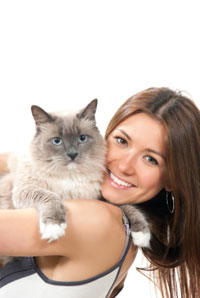How To Nurse Your Cat at Home
 Dealing with chronic illness in a cat can be exhausting and demanding when it requires ongoing home nursing care. Not everybody can allot the time and energy required for a home care program. Before you begin such a long-term nursing assignment, speak with your veterinary healthcare team about time, expense, and anticipated challenges.
Dealing with chronic illness in a cat can be exhausting and demanding when it requires ongoing home nursing care. Not everybody can allot the time and energy required for a home care program. Before you begin such a long-term nursing assignment, speak with your veterinary healthcare team about time, expense, and anticipated challenges.
Home Nursing Care Can Be Easier Than You Think
Sometimes though, home care of a sick kitty is not onerous at all, and once you become familiar with the nursing techniques prescribed for your pet, the home care may bring you a great deal of satisfaction. This arises from knowing that you are doing your very best and giving your cat a chance to live with their illness until such time as it progresses to a point where all management efforts will not be enough to maintain comfort.
Caregiver infirmity may interfere with nursing an uncooperative kitty, while provision of nursing care to a cooperative kitten may be achievable for that same individual. Work with your veterinarian to establish how realistic care plans will be once you take your cat home.
Cost can also be a very real concern. Even though home care will save hospitalization fees, sometimes specialized equipment and medications will add up over time. In advance, discuss anticipated costs with your veterinarian so you know what to expect. Remember, though, Fluffy can’t read the book about costs, and these expenses may escalate if the condition takes a turn for the worse, so the estimate is just that—an estimate.
Home nursing care can encompass many modalities. In addition to nursing techniques, medication to control pain, nausea, or other symptoms may be prescribed.
Physical Therapy for Cats
The purpose of this type of care is to prevent scarring and contracture of damaged tissues, to provide increased range of motion for damaged joints, and improving blood flow to damaged tissues. There are a number of physical therapy modalities. Note that manipulation should not be continued if pain is noted.
Some examples of physical therapies will help to demonstrate their role. Passive joint manipulation may be prescribed to help healing and improve joint range of motion in a case where a fall has injured the tissues around a joint and healing has begun. Some of these techniques may be done by a trained animal physiotherapist or veterinarian periodically, as well. For a recumbent patient (a cat that cannot get up), regular turning and limb stretching will help to prevent sores and pneumonia and restore tissue circulation. Gentle massage of muscle masses improves circulation and helps prevent swelling from fluid buildup. The sensation of contact is also a pleasant one and helps the emotional health of the ill cat.
Home Cooking for a Sick Cat
Sometimes for the ill kitty, even canned cat food just doesn’t cut it. If the cat has eaten his regular food while in pain, he may develop an aversion to that food. Substituting palatable balanced home formulations can provide a short-term boost to a failing appetite. This may be against the grain of what your vet has told you about not feeding people food to your cat, but in special circumstances, this strategy may be required to help support a very ill patient that does not want to eat.
Commercial gravy flavor enhancers may be provided or calorie-booster pastes prescribed.
Note that a home diet will be prescribed by your vet and must be carefully prepared to maintain a balanced diet. Just dropping your leftovers into the dish or fixing non-stop tuna or liver is a recipe for disaster.
Fresh is important but raw diets are definitely a no-no for a chronically ill patient. Most raw meats have bacteria contamination and these can be life-threatening to an immune suppressed patient.
Sometimes hand-feeding is necessary to encourage increased food intake.
If appetite continues to be a problem, a feeding tube may be surgically implanted, and home feeding may occur through the tube using special critical care diets.
Special nutritional supplements may also be recommended, depending on the type of condition.
Home Wound Care for Cats
Only apply bandages to your cat under veterinary prescription. Dressing wounds, whether post-surgical, traumatic, or ulcers, requires careful attention to cleanliness and technique. If a feeding tube has been placed, careful attention to the entry point at the skin will help to reduce chances of infection. Make sure you understand how to apply a bandage properly, and make sure it stays dry and clean. Monitor toe tips for swelling and coldness when a limb is bandaged, and if the bandage slips or is chewed or otherwise damaged, replace it immediately. Be warned: cats hate bandages. Follow advice for the recommended period of bandage replacement. If tissues (or the wound) become smelly or discolored or if a bandage slips or pinches and swelling occurs, take your cat to see the veterinarian immediately.
TLC for Your Cat at Home
Tender loving care is hard to quantify, but provision of a warm, soft bed in a quiet area of the home and regular doses of petting and soothing voice does wonders. Your cat relies on you for care, and praising him for taking medication or tolerating bandage changes will make everything easier. Keep the cat near the family when possible so the amount of family contact is maximized.
Environmental Cleanliness and Hygiene for a Cat Nursed at Home
An ill pet is susceptible to many environmental agents that normally are successfully dealt with by a healthy pet. Sometimes an ill pet may be receiving a medication that actually suppresses the immune system and leaves him vulnerable to serious infection (e.g., chemotherapy for a cancer patient). Sometimes the illness itself causes increased risk of infections (e.g., diabetes, associated with bladder and other infections).
If you are cleansing wounds and changing bandages, you should also avoid being exposed to pus and other infected debris. Wear gloves and clean up spilled materials with disinfectants. If you as caregiver have a chronic illness, discuss this with your physician to ascertain whether you are also at increased risk of contracting infections. Dispose of the bandage materials as per your veterinarian’s instructions. Do the nursing procedures in an area of the home that is easily wiped clean. A bathroom floor will be more easily disinfected than your rugs.
The decision to do long-term nursing should be done in concert with your veterinary healthcare team—talk to them.
You May Also Like These Articles:
Alternative and Holistic Veterinary Medicine for Cats
How To Give Liquid Medications
Human Medications That Are Dangerous to Cats
Safe Handling of Feline Medications
Administering Medications to Cats
Notice: Ask-a-Vet is an affiliated service for those who wish to speak with a veterinary professional about their pet's specific condition. Initially, a bot will ask questions to determine the general nature of your concern. Then, you will be transferred to a human. There is a charge for the service if you choose to connect to a veterinarian. Ask-a-Vet is not manned by the staff or owners of CatHealth.com, and the advice given should not delay or replace a visit to your veterinarian.





